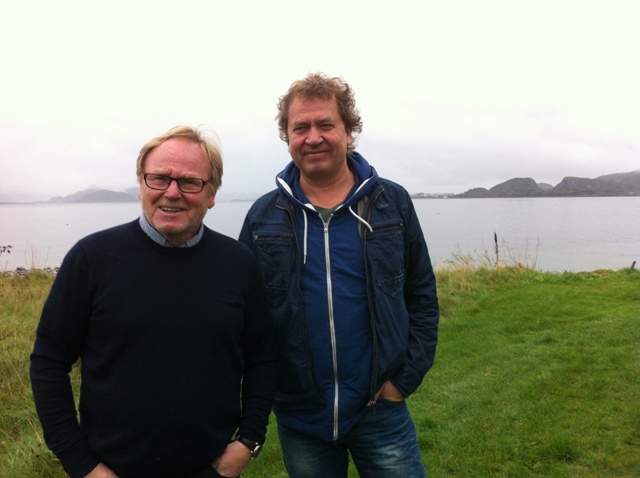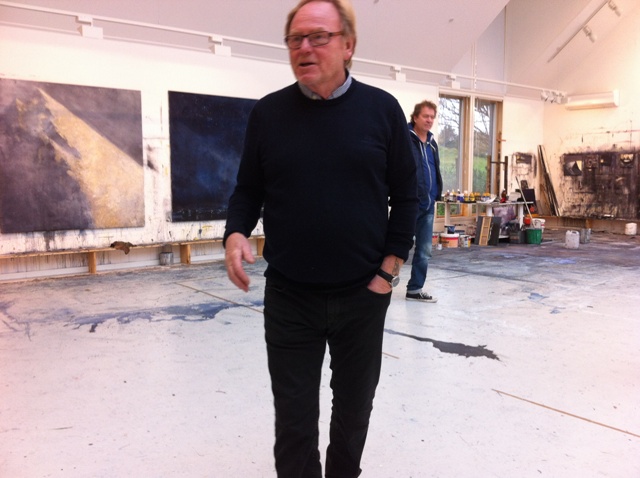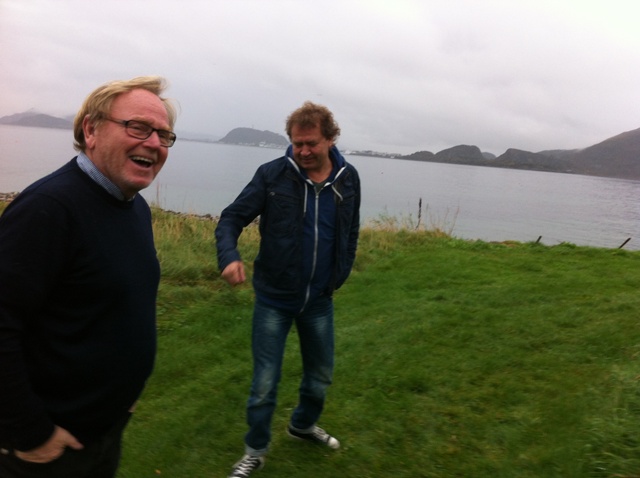It was a windswept day in Ålesund, the small town on the west coast of Norway known for its art nouveau and as the fishing capital of Norway. Looking out over the town from a vantage point high over the streets it was just possible to make out the island of Sula in the shimmering distance where trumpeter Nils Petter Molvær grew up.
Through the murk of a wet but warm autumnal morning the shape of the distant island where Molvær who has just completed his latest album, working title Switch to be released by OKeh via a licensing deal arranged by his own label Sula which takes its name from the very island out there, somewhere across the almost preternaturally still water.
On the island's wild, open spaces Molvær, whose album Khmer in 1997 changed the face of European jazz for a new “future jazz” generation, and who is artist-in-residence at November’s Scene Norway 2 at Kings Place in London, was a cross country runner and ski jumper as a boy, and fished in the fertile waters.
As the wind whipped up and the rain subsided, Molvær made his way into the artist’s studio not far from Sula of painter Ørnulf Opdahl on the island of Godøy, and who will exhibit as part of the Scene Norway programme in the Kings Place Gallery. The painter, who turns 70 in January was standing besides crates from which he had unpacked some of his work glad to have the paintings back from an exhibition in Seattle, and he was making finishing touches to his canvases bound for London and deciding the final choices.
Inspired by the dramatic west Norwegian landscape of fjords and mountains, his journeys with his sketch books on sea trips to the far north and even down to Antarctica is a natural very personal vision that works on several levels. Primarily, though, it’s the fast changing light where nothing quite seems the same twice that informs his work which has an abstract beauty to it, full of rich forboding atmospheres and the drama of the dark in a land of silence. Several of his paintings would not be out of place on the covers of ECM albums, a label Molvær made his name with, and Opdahl’s work is highly collectable with several of his paintings owned by Queen Sonja of Norway who is a regular visitor to Opdahl’s studio.
Later in the nearby Alnes Lighthouse, which doubles as a restaurant where Opdahl has donated artwork that decorates the stairwells visitors can see as they climb up to the viewing platform with its remarkable views of the majestic landscape, he sits with his wife Sidsel Colbiørnsen, herself a tapestry textile artist, in front of a gleaming white tablecloth speculating about the choice of sweet cake to have later with his coffee, smiling at the thought. Opdahl’s jolly manner and youthful demeanour light up the room.
The curator of Scene Norway 2 is BBC Radio 3 presenter Fiona Talkington, long known for her championing of and immersion in Norwegian jazz and improvised music. “I chose Nils Petter,” she says, “because although he’s a well known figure on the UK jazz scene, all too often he’s on tour and we don’t get a chance to really get to know him, and appreciate his different musical approaches and learn more about his important place in Norwegian jazz history.”
Molvær at Scene Norway 2 (coming five years after the first gathering in Kings Place shortly after the venue’s opening) will also collaborate with another artist, the visual artist Tord Knudsen. “It’s an audiovisual concept”, Molvær says, and his residency will also resume his relationship with UK/Norwegian ensemble Spin Marvel who he has played with a few times in the UK including gigs when Led Zeppelin’s John Paul Jones joined. Molvær speaks highly of Jones (“the brains behind Led Zeppelin,” he says) and mentions that Jones has a deep relationship with the Norwegian improvised music scene, and especially the band Supersilent. Molvær has a high regard, too, for Martin France, the leader of Spin Marvel and the Norwegian and Englishman have been working on a follow-up to the band’s 2010 album The Reluctantly Politicised Mr James released by Cardiff indie Edition, one of the label’s best sellers to date. “But I’m just a guest,” he’s quick to point out. Spin Marvel have been part of Talkington and Nasjonal Jazzscene Oslo’s Conexions series, and at Scene Norway 2 the band will perform in a double bill with another Ålesund musician, the singer Hilde Marie Kjersem, who is making her London debut.
Later back in the town itself Opdahl, squelching his way along the dripping wet street not far from the town’s lapping breakwater, proudly shows where the next generation of young Ålesund jazz musicians get a chance to play thanks to bursaries and opportunities provided by a trust he’s chair of funded by a cod liver oil factory’s charitable foundation. A new building rising from the ashes of a derelict wreck is also taking shape, and there will be space for chamber performances just along from the fascinating theatre café full of vintage furniture, reconditioned chaises longues, old radios and the like, and big enough to host the hundreds of people who stream off the cruise ships in the summertime.
Lunch over in the Lighthouse Molvær goes across to the residential Ocean Sound Recordings studio at Giske where he checks out a new mastering studio adjacent to the complex that he is considering hiring. The main studio was the atmospheric setting for Baboon Moon an album that saw Molvær work with guitarist-of-the-moment Stian Westerhus, a natural successor in a different idiom to Terje Rypdal, plus also on the record drummer Erland Dahlen and Susanne Sundler. The album marked, it’s fair to say, a high water point in Molvær’s recent work.
Molvær speaks readily of his influences and mentions such disparate trumpeters as Jon Hassell and Don Ellis but also Joni Mitchell when he sits down to talk in the mastering studio. “But the trumpeter who influenced me most was Don Cherry as well as Miles, Hassell, and Chet Baker.” Molvær’s whispery electro-acoustic ambient tone and dramatic attack is something he has developed over many years and he talks of his plans for London including “minimalistic solos” and an improvisation at the beginning of Opdahl’s exhibition.
At the forefront of innovation in his own area of improvised music that also connects with DJ culture it’s not surprising that Molvær is close to another leading Norwegian artist Jan Bang, and during Scene Norway 2 he will also be working with the live sampler, as part of the Not So Silent Movies series, and a renewal of his collaboration with Bang at the Kristiansand Punkt festival. Molvær likes to travel with a sound engineer and sees this as a crucial element in the sound design of his work. He can’t risk using a venue’s sound engineer when the sonic possibilities depend on an approach only an experienced sound engineer briefed by him really knows. “If there’s someone behind the desk who doesn’t give a shit it can easily ruin a good concert,” Molvær says, and who’s to disagree? As for visuals he likes abstract visual and live image mixing so the images can “interact with the improvising."
The trumpeter likes to refer to his approach as “totally open” and it’s more and more his method these days. Little is prepared in advance. “It keeps the edge.” Nothing if not eclectic and besides keeping up regular contact with Bill Laswell (expressing great enthusiasm for Laswell’s work on Panthalassa when Laswell reimagined Miles’ late electric period) Molvær also tours with Moritz von Oswald, a collaboration Molvær describes as “very dark, trancey and dubbish.” As for his own album which he’s still finessing he says it’s about a “total sonic landscape and is very acoustic with pedal steel, Indian guitar, banjo and piano.” He likes to liken the trumpet to the human voice and it’s fair to say Molvær, who is 53, has influenced a new “next” generation of Norwegian improvisers, chief among them Arve Henriksen and Mathias Eick, and he says with some pride that he was responsible for introducing Henriksen to the shakuhachi sound by giving him a cassette to listen to.
One thing is for sure Molvær does not see his music as existing in a vacuum, and he has a voracious appetite for drawing on disparate sources. Yet the landscape of Ålesund and the wider Sunnmøre area are hard wired into his artistic DNA just as it in a very different more naturalistic way rendered abstract is in Opdahl’s highly mood-enhancing art. Both approaches lie at the heart of Scene Norway 2, a metaphor of landscape, music, silence, and artistry in many guises. Story and pictures: Stephen Graham
Pictured top and in other shots: Ørnulf Opdahl, left, and Nils Petter Molvær
Scene Norway 2 curated by Fiona Talkington, with Nils Petter Molvær, Spin Marvel, Hilde Marie Kjersem, Sidsel Endresen, Jan Bang and Annbjørg Lien, and an associated exhibition by Ørnulf Opdahl, takes place at Kings Place in London from 15-17 November. Tickets: www.kingsplace.co.uk


